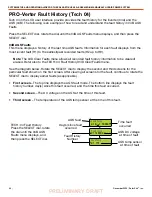
December 2020
|
Solar Stik
®
, Inc.
78
|
SYSTEM SETUP AND OPERATION GUIDE FOR THE SOLAR STIK USAF G-BOSS MEDIUM AND HEAVY HYBRID POWER SYSTEM
PRELIMINARY DRAFT
Energy Storage Modules—Supplemental Information
Batteries in high-efficiency hybrid power systems will cycle as they work. The total amount of
battery cycles that can be expected is called the cycle-life of the battery, and this is usually
associated with the chemistry and the type of cycling that occurs (light or heavy duty). The G-BOSS
HPS uses LiFePO
4
batteries as its primary energy storage mechanism.
One of the most important factors in maximizing battery cycle-life is to make sure that it is sized
properly for a load. Since batteries store energy, they have ratings that correspond to the total
amount of energy they can hold. This is known as battery capacity.
In any high-efficiency (hybrid) power system, it is critical to have the proper amount of battery
capacity, as it will directly affect the overall performance of the system.
A properly sized battery should meet the following criteria:
• It should be able to provide the total power required by a load at any given point during
operation.
• It should be able to fully recharge from the selected power generation sources at regular
intervals.
• It will ensure there is enough energy to power the intended load between charges.
The best measure of a properly sized battery in a cycling application is that it will cycle 1-2 times
during a 24-hour period. Improper sizing of a battery bank will cause improper cycling, which leads
to shortened battery life and poor use of other resources such as fuel (if a generator is used to
recharge the batteries).
When assembling multiple batteries or ESMs into a bank for a particular application, the following
need to be considered:
• Consistency of chemistry
• Consistency of operating voltage
• Commonality of cycles (similar age, cycle exposures)
• A single battery bank (connected together and not disparately)
The HPS battery bank is sized directly for the 300W continuous load that may be placed on it when
in support of the mission. If the load requirements change, then the size of the battery should also
be reconsidered.
Life Expectancy of a Battery
The battery is the “consumable” part of any hybrid system... It is sacrificial. The chemical reaction
in a battery never stops, but it can be controlled in ways that affect the life expectancy and the
cycle-life it will provide.
Primary factors that determine the life expectancy of a battery:
1. Cycles
• Chemistry
• Application (operating conditions, C-rates, etc.)
2. Abuse
• Storing in a discharged state
• Improper cycling






















